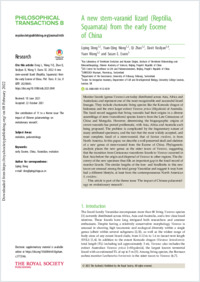A new stem-varanid lizard (Reptilia, Squamata) from the early Eocene of China
DOKPE
- Dong, Liping ORCID Institute of Vertebrate Paleontology and Paleoanthropology, Chinese Academy of Sciences, Beijing
- Wang, Yuan-Qing Institute of Vertebrate Paleontology and Paleoanthropology, Chinese Academy of Sciences, Beijing
- Zhao, Qi Institute of Vertebrate Paleontology and Paleoanthropology, Chinese Academy of Sciences, Beijing
- Vasilyan, Davit University of Fribourg
- Wang, Yuan Institute of Vertebrate Paleontology and Paleoanthropology, Chinese Academy of Sciences, Beijing
- Evans, Susan E. University College London
- 07.02.2022
Published in:
- Philosophical Transactions of the Royal Society B: Biological Sciences. - Accepted version. - 2022, vol. 377, no. 1847, p. 20210041
English
Monitor lizards (genus Varanus) are today distributed across Asia, Africa and Australasia and represent one of the most recognizable and successful lizard lineages. They include charismatic living species like the Komodo dragon of Indonesia and the even larger extinct Varanus prisca (Megalania) of Australia. The fossil record suggests that living varanids had their origins in a diverse assemblage of stem (varaniform) species known from the Late Cretaceous of China and Mongolia. However, determining the biogeographic origins of crown-varanids has proved problematic, with Asia, Africa and Australia each being proposed. The problem is complicated by the fragmentary nature of many attributed specimens, and the fact that the most widely accepted, and most complete, fossil of a stem-varanid, that of Saniwa ensidens, is from North America. In this paper, we describe a well-preserved skull and skeleton of a new genus of stem-varanid from the Eocene of China. Phylogenetic analysis places the new genus as the sister taxon of Varanus, suggesting that the transition from Cretaceous varaniform lizards to Varanus occurred in East Asia before the origin and dispersal of Varanus to other regions. The discovery of the new specimen thus fills an important gap in the fossil record of monitor lizards. The similar lengths of the fore- and hindlimbs in this new taxon are unusual among the total group Varanidae and suggest it may have had a different lifestyle, at least from the contemporaneous North American S. ensidens.
- Faculty
- Faculté des sciences et de médecine
- Department
- Département de Géosciences
- Language
-
- English
- Classification
- Earth sciences
- License
- License undefined
- Open access status
- green
- Identifiers
- Persistent URL
- https://folia.unifr.ch/unifr/documents/313055
Statistics
Document views: 66
File downloads:
- Dong_New_Stem-Varanid_Lizard.pdf: 246
